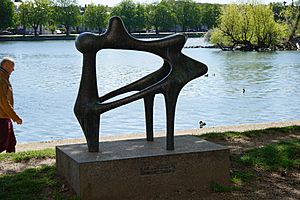Sonja Ferlov Mancoba facts for kids
Sonja Ferlov Mancoba (born November 1, 1911 – died December 17, 1984) was a Danish artist who made amazing sculptures. She was known for her modern and unique art.
Contents
Early Life and Training
Sonja Ferlov Mancoba was born in Copenhagen, Denmark. She first trained to be a painter. From 1930 to 1932, she studied with an artist named Bizzie Høyer. Then, from 1933 to 1935, she attended the Royal Danish Academy of Fine Arts.
In 1935, she showed her art for the first time at an event called the Artists' Autumn Salon. She displayed two sculptures made of plaster: Bird with Young and Two Living Beings.
Joining Art Groups
In the mid-1930s, Sonja became part of an art group and a magazine called Linien (The Line). This group helped bring a new art style called Surrealism from France to Denmark. Surrealism is an art style that uses dream-like images and ideas.
During this time, she worked with other artists like Ejler Bille, Vilhelm Bjerke-Petersen, and Richard Mortensen. They created art that mixed abstract shapes with Surrealist ideas. Sonja also made sculptures from natural things like branches. These were inspired by artists like Jean Arp and Kurt Schwitters. In 1936, she showed a sculpture called The Owl, but it was later destroyed.
Life in Paris
In 1937, Sonja Ferlov Mancoba moved to Paris, France. There, she met famous Surrealist artists like Max Ernst and Alberto Giacometti. Giacometti's art studio was in the same building as hers.
In Paris, she also met Ernest Mancoba, who was an artist from South Africa. They got married in 1942. Their son, Wonga (1946–2015), also grew up to be a respected artist. Sonja was already interested in art from different cultures. In Paris, she learned even more about art from non-Western countries at the Musée de l'Homme museum.
When World War II started, she briefly returned to Copenhagen. But she spent the rest of the war in France. During this time, Ernest Mancoba was held in a prisoner-of-war camp.
Later Years and Art Style
From 1947 to 1951, Sonja was back in Denmark. She showed her art with other groups like Linien II and Høst. After 1952, she lived in France again. In 1969, she joined an art group called Den Frie Udstilling (The Free Exhibition).
Sonja Ferlov Mancoba's sculptures often looked like living things or natural shapes. She used or made her art look like organic materials. Around 1948, she also briefly made sculptures with geometric, abstract shapes.
Awards and Recognition
Sonja Ferlov Mancoba received several important awards for her art:
- Statens Kunstfond (National Art Fund) award in 1964
- Tagea Brandts travel grant in 1971
- Thorvaldsen Medal in 1971
- Niels Larsen-Stevns Medal in 1977
Where to See Her Art
Sonja Ferlov Mancoba's sculptures are displayed in many art museums. Some of these include:
- Aarhus Kunstmuseum
- Holstebro Kunstmuseum
- Den Kongelige kobberstiksamling
- Louisiana Museum of Modern Art
- Brandts Museum of Photographic Art
- Moderna Museet
- Museum Jorn, Silkeborg
- Statens Museum for Kunst
- Kunsten - Museum of modern Art Aalborg
See also
 In Spanish: Sonja Ferlov para niños
In Spanish: Sonja Ferlov para niños


